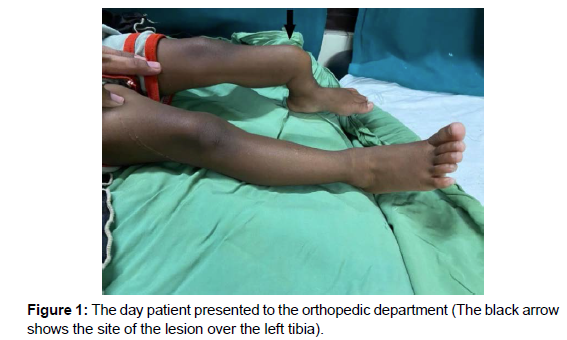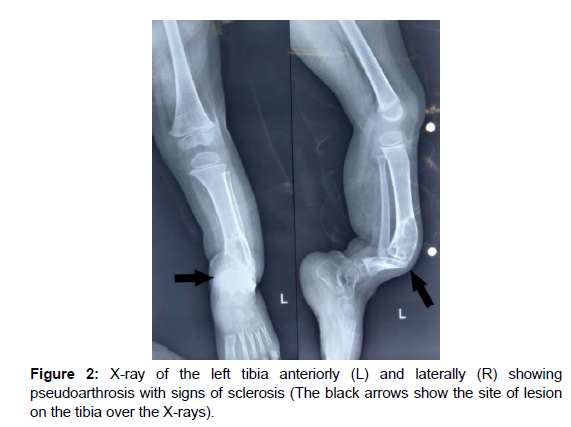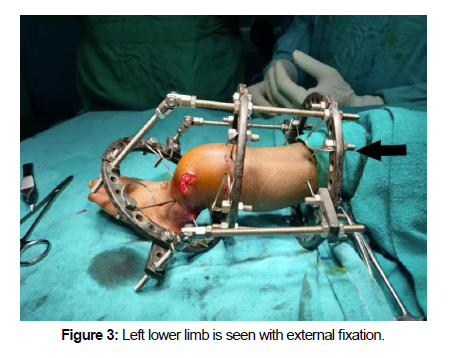A Toddler's Rehabilitation Following Ilizarovâs fixation for Tibial Pseudoarthrosis due to Addiction
Received: 05-Jul-2022 / Manuscript No. jart-22-71001 / Editor assigned: 07-Jul-2022 / PreQC No. jart-22-71001 (PQ) / Reviewed: 21-Jul-2022 / QC No. jart-22-71001 / Revised: 23-Jul-2022 / Manuscript No. jart-22-71001 (R) / Accepted Date: 25-Aug-2022 / Published Date: 30-Jul-2022 DOI: 10.4172/2155-6105.100480
Abstract
Pseudoarthrosis of the tibia is one of the rare conditions in children; it causes a deformity in the tibia of the affected leg, causing the tibia to bend backward. Our patient came to the physiotherapy department for postoperative management of Ilizarov's external fixator because he experienced something similar. When the patient initially arrived at the department, her ankle ranges were almost non-existent, and her hip and knee ranges had been reduced along with her strength in the affected limb. Her physiotherapy regimen was meticulously designed keeping in mind her age and the activities that she shall enjoy so that we may effortlessly achieve our desired outcome through this play therapy. After a month of giving her routines to follow at home, we observed significant improvements in her strength and joint ranges, leading to the conclusion that physiotherapy is indeed helpful in this novel condition.
Keywords
Pseudoarthrosis tibia; Physiotherapy; Ilizarov’s fixation; Case report.
Introduction
Congenital pseudarthrosis of the tibia (CPT) is one of the rare conditions that can manifest itself in a variety of ways, from simple tibial angulation anterolaterally to total non-union with severe bony abnormalities. The link between type 1 neurofibromatosis and CPT is well understood, although the specific etiology is yet unknown. The fibrous soft tissue and aberrant periosteum observed in pseudarthrosis are undoubtedly important in the pathophysiology probably due to diminished osteogenic capabilities and altered local vascularization [1]. Its management is challenging and spans many years. The goal of decision-making should stay on long-term function. The use of bone rod constructions, morphogenic proteins, and guided growth in deformity correction has resulted in the most significant improvements in care in recent years. One of the key advantages of an external fixation technique, which was first described by Ilizarov in 1971, is that it can be used to treat pseudoarthrotic lesions along with all their possible consequences such as leg length discrepancy, refracture, and ankle valgus, all at once. Ilizarov’s procedure has the advantage of being able to provide a multitargeted approach; external fixation can be employed for distraction, compression, or bone transfer at various tibial levels. The technique's possible drawbacks include the complexity and length of the treatment, as well as the possibility of infection. It has also been shown that hyperemic activation of distraction osteogenesis can cause femoral overgrowth [2]. 50% patients who have been treated with Ilizarov’s technique have achieved good results [3]. To avoid joint contractures and subluxations, which in this situation arise owing to muscle irritation caused by pins or cables impaling them, meticulous physiotherapy is required. The importance of physiotherapy in the successful implementation of the Ilizarov’s procedure is obvious because stretching and conserving range of motion are critical to preventing contractures, dislocations and subluxation, while functional loading and ambulation are needed for ossification of the regenerating bone [4].
Patient Information
A 2-year-old girl presented with her parents to the orthopedic department for a bent leg (Figure 1),
When she visited the physiotherapy department, she was examined thoroughly in supine lying, she was conscious, oriented, co-operative with normal vitals and was well in line with the developmental milestones except that she couldn’t walk or do activities that require weight-bearing on both the limbs. There was a localized deformity on her left tibia, which was bent backward distally and an Ilizarov’s fixator was seen over it, there was no significant muscle wasting, discoloration, edema, swelling or temperature rise in and around that area and an open wound was visible (Figure 3).
On movement examination, a definite muscle spasm was palpable on the left leg muscles surrounding the tibia, right lower limb joints were within normal ranges and end feels. On the left side, ankle movements were nearly lost, reduced left knee range of motion (ROM), approximate ranges of left lower limb is provided in table 1 (Table 1).
| Joint | Movement | ROM of left lower limb | |
|---|---|---|---|
| Active | Passive | ||
| Ankle | Plantarflexion | 0° | 5° |
| Dorsiflexion | 0° | 0° | |
| Inversion | 0° | 0° | |
| Eversion | 0° | 0° | |
| Knee | Flexion | 90° | 90° |
| Extension | 0° | 0° | |
| Hip | Flexion | 90° | 90° |
| Extension | 10° | 15° | |
| Internal rotation | 10° | 15° | |
| External rotation | 15° | 20° | |
| Abduction | 30° | 40° | |
| Adduction | 10° | 15° | |
Table 1: Range of motion of left lower limb joints.
End feels on the left side were firm in the knee and hip but hard bony over the ankle joint. Manual muscle testing grading on the right was slightly reduced while that on left side was severely reduced (Table 2). There was an obvious limb length discrepancy with a difference of 8 cm from the right lower limb. The girth of the thigh was bilaterally equal but that of the leg was different because of the bulking of the muscle at a site due to the deformity and possible wasting of the muscles of the left lower leg.
Joint |
Muscles | Grading | |
|---|---|---|---|
| Left | Right | ||
| Ankle | Plantarflexors | 2 | 3 |
| Dorsiflexors | 1 | 3 | |
| Inverters | 1 | 3 | |
| Everters | 1 | 3 | |
| Knee | Flexors | 3 | 3 |
| Extensors | 3 | 3 | |
| Hip | Flexors | 3 | 3 |
| Extensors | 3 | 3 | |
| Internal rotators | 3 | 3 | |
| External rotators | 3 | 3 | |
| Abductors | 3 | 3 | |
| Adductors | 3 | 3 | |
Table 2: Manual muscle test grading.
Therapeutic Interventions
Her regimen was made by keeping her age in mind. The goals of the treatment were framed after a detailed discussion with her parents. They were counseled regarding the approaches, duration, and what to expect from the physiotherapy treatment and about the implementation of the home exercise program. Her goals and necessary interventions required to reach that goal are provided below in table 3 (Table 3). The duration of the dosage of the interventions have not been specified because of the unpredictable time period required to bring the limb back to normal. Hence, the regimen is expected to be performed till the end of the orthopedic treatment with progressions as preferred by the physiotherapist. While as the frequency of every intervention will be 5 times daily, keeping in mind the energy expenditure that a child does at this age. While progressing the regimen forward the frequency of these interventions will be increased gradually.
Sr. no. |
Goals | Physiotherapy intervention | Rationale |
|---|---|---|---|
| 1. | Pain reduction | Ice massage | Ice reduces the pain by numbing the area i.e., action through pain gait mechanism. |
| 2. | To reduce or prevent limb edema | Elevation and toe movements | Gravity assists with edema drainage in elevation and toe movement facilitates the same |
| 3. | To prevent or relieve muscles and fascia tightness | Myofascial release | This loosens up the muscles and fascia and prevent them from going into tightness. |
| 4. | Providing patient proprioceptive sensations | Making the patient stand on a walking frame | While doing this activity she gained proprioception through the non-affected extremity and through the affected extremity when it touched the ground. |
| 5. | Gaining or maintaining normal range of motion of the adjacent joints i.e., hip, knee and possibly ankle | Kicking ball while standing on the walking frame in every direction | Since the patient was a child, she could not understand the commands of the therapist hence the hip and knee ranges were actively maintained as well as improved with play therapy |
| Hydrotherapy | When the child was immersed in the pool she moved her limbs by herself to enjoy the water and thus we gained the range of every joint effortlessly. | ||
| 6. | Maintaining the strength of the muscles of adjacent joints | Making the child to squeeze a sponge ball below the buttocks, thighs and Ilizarov’s | To further increase the strength of the limb, isometrics were added in this way. |
Table 3: Physiotherapy intervention.
Follow-Up And Outcome Of Interventions
The patient was called for follow-up every month for the progression of her regimen. The outcome measures that were used for evaluation at one month are the range of motion of the knee ankle and foot and manual muscle testing of the major muscles surrounding the joint. Both of the outcome measures were improved significantly from the first day of evaluation (Tables 1 and 2). The overall improvement in the ranges was grossly of 5° and that of manual muscle testing was grade 3+ for the muscles that were graded 3 on day 1 (Table 2) but the muscles having grade 1 and 2 remained unchanged.
Discussion
An Ilizarov’s external fixator-stabilized limb must be used in a physiologic manner for the whole period. For appropriate growth and ossification, weight-bearing for lower extremity and functional use of upper limbs are required. Myofascial tissues resist elongation during any Ilizarov's surgery involving bone segment movement-whether lengthening, deformity repair, or bone transport leading to either progressive deformity at the site of a corticotomy or joint contractures that can develop to subluxations and dislocations. As a result, for the duration of a patient's fixation, intense physiotherapy, dynamic and static splinting, and optimal sleep positions must be used [4]. A study showed that early range of motion exercises and weight bearing should be emphasized since immobilization does not appear to be beneficial [5]. Use of hydrotherapy in Ilizarov’s fixator was also surveyed through a study in 1999 [6-10], through which we got the idea of training this child in water for her ranges as well as strength. All in all, most physiotherapy approaches are basic, such as icing, hydrotherapy and myofascial release, but others have been modified to meet her age, such as kicking a ball through the affected limb while bearing weight on the non-affected on a standing frame, squeezing a sponge ball below various areas of the lower limb, such as below the thigh or leg for the purpose of isometric strengthening and so on [11-15].
Conclusion
Physiotherapy plays a major role for a child with pseudoarthrosis of the tibia rehabilitating with and from Ilizarov’s fixator. From the improvement in the outcome measures it is evident that patient has improved her joint ranges and strength since the day of evaluation, these are beneficial to her for attaining the developmental milestone of standing, walking and running independently.
Acknowledgement
We thank our college for this opportunity to publish this unique case and the patient to provide consent for the same.
Authors’ Contribution
DJ suggested the idea of the case-report, TML formulated the manuscript, DJ and PP finalized the manuscript for publication process.
Funding
This study has not received any external funding.
Conflict of Interest
The authors declare that there is no conflict of interests.
References
- Pannier S (2011) Congenital pseudarthrosis of the tibia. Orthopaedics Traumat Surg Res 97:750-761.
- Eisenberg KA, Vuillermin CB (2019) Management of Congenital Pseudoarthrosis of the Tibia and Fibula. Curr Rev Musculoskelet Med 12: 356-368.
- Javaid MZ, Khan J, Javaid MM, Zafar Z, Shakir IA,et al. (2020) Outcome of Congenital Pseudoarthrosis Tibia Treated with Illizarov Fixator in Children. Intern J Orthopaedics 7: 1289-1292.
- Green SA (1990) Physiotherapy during Ilizarov fixation. Techniques in Orthopaedics 5: 61-65.
- Iliopoulos E, Galanis N (2020) Physiotherapy after tibial plateau fracture fixation: A systematic review of the literature. SAGE Open Med 8:2050312120965316.
- Barker K, Burns M, Littler S (1999) Physiotherapy for Patients with an Ilizarov External Fixator: A Survey of current practice. Physiotherapy 85: 426-432.
- de Vries MG, Brazil IA, Tonkin M, Bulten BH (2016) Ward climate within a high secure forensic psychiatric hospital: Perceptions of patients and nursing staff and the role of patient characteristics.Arch psychiatr Nurs30: 342-349.
- Strobbe S, Crowley M (2017) Substance Use among Nurses and Nursing Students: A Joint Position Statement of the Emergency Nurses Association and the International Nurses Society on Addictions. J Addict Nurs 28:104-106.
- Gamble MA (2018) Implementation of Peer Support Groups for Nurses in Delaware's Professional Health Monitoring Program. Wilmington University (Delaware), ProQuest Dissertations Publishing, 10812395.
- Heise B (2003) The historical context of addiction in the nursing profession: 1850-1982.J Addic Nurs14: 117-124.
- Hood JC, Duphorne PL (1995) To report or not to report: Nurses' attitudes toward reporting co-workers suspected of substance abuse.J Drug Iss 25: 313-339.
- Horsfall J, Cleary M, Hunt GE, Walter G (2009) Psychosocial treatments for people with co-occurring severe mental illnesses and substance use disorders (dual diagnosis): A review of empirical evidence.Harv Rev Psychiatry17: 24-34.
- Miller T (2014) A qualitative phenomenological study: Hiring nurses re-entering the workforce after chemical dependence. J Nurs Edu Prac 5: 65-72.
- Stadnek MA (2018) Problematic substance use among nurses: a knowledge translation campaign.Doctoral dissertation, University of British Columbia Library, USA.
- Darbro N (2005) CE FEATURE Alternative Diversion Programs for Nurses with Impaired Practice: Completers and Non-Completers.J Addic Nurs 16: 169-185.
Indexed at, Google Scholar, Crossref
Indexed at, Google Scholar, Crossref
Indexed at, Google Scholar, Crossref
Indexed at, Google Scholar, Crossref
Indexed at, Google Scholar, Crossref
Indexed at, Google Scholar, Crossref
Indexed at, Google Scholar, Crossref
Indexed at, Google Scholar, Crossref
Indexed at, Google Scholar, Crossref
Indexed at, Google Scholar, Crossref
Indexed at, Google Scholar, Crossref
Citation: Lakkadsha TM, Jain D, Phansopkar P (2022) A Toddler's Rehabilitation Following Ilizarov’s fixation For Tibial Pseudoarthrosis Due to Addiction. J Addict Res Ther 13: 480. DOI: 10.4172/2155-6105.100480
Copyright: © 2022 Lakkadsha TM. This is an open-access article distributed under the terms of the Creative Commons Attribution License, which permits unrestricted use, distribution, and reproduction in any medium, provided the original author and source are credited.
Share This Article
Recommended Journals
Open Access Journals
Article Tools
Article Usage
- Total views: 1397
- [From(publication date): 0-2022 - Jul 17, 2024]
- Breakdown by view type
- HTML page views: 1210
- PDF downloads: 187



